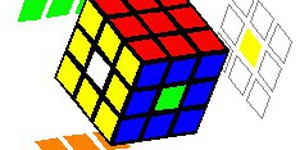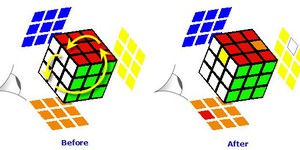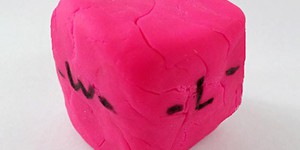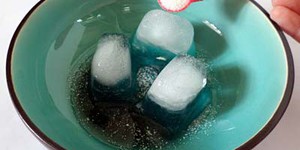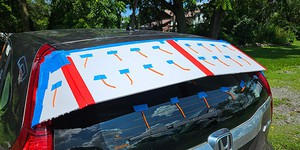Others Like “The Fastest Way To Solve a Rubik's Cube” (top 20 results)
|
This project challenges you to figure out how to make geometric patterns with Rubik's Cube. Leaving your cube in one of these positions makes it much more tempting to pick it up and 'fix' it. Can you figure out how to make a checkerboard, or a cube-within-a-cube? Can you make only the center piece a different color from the rest? Can you figure out how to solve the cube from these positions?
Read more
If you're the kind of person who has taken apart your Rubik's cube in order to grease the inside parts so it will move more smoothly, this could be a great project for you. We'll show you three sets of move sequences that accomplish specific rearrangements of the cube. Can you devise a way to solve the cube using only these three move sequences?
Read more
Have you ever had fun making different figures or colorful creations using some Play-Doh? You can squish and stretch a single piece of Play-Doh® to make all sorts of shapes. How does changing the shape of a piece of Play-Doh affect its volume? In this science project, you will find out by testing how changing a piece of dough's shape affects its dimensions (length, width, and height), and how these changes are related to the dough's volume.
Read more
If you live in a place that gets cold in the winter, you have probably seen trucks out spreading a mixture of sand and salt on the streets after a snowfall to help de-ice the road. Have you ever wondered how this works? This basic chemistry project can give you some clues.
Read more
Did you know that the average child sees 20,000 30-second TV commercials in just one year? That's a lot of encouragement to buy new toys, clothes, entertainment, and food. In this behavioral science fair project, you'll find out some other ways (besides commercials) that marketers use to try and get adults to buy products, like having them touch or hold an item. You'll find out if these methods work with kids, too, and if they increase how much people are willing to pay for a product. It's a…
Read more
You can model this with an ice cube sliding down a plank: how high do you need to lift the end of the plank before the ice cube starts to slide? Try this with one side plain wood and the flip side waxed wood (use paraffin wax, candle wax or ski wax). Make sure both sides are equally smooth to start with. Do at least three trials. More advanced: using what you know about the forces acting on the ice cube, derive equations to calculate the coefficient of friction for each case. Variation:…
Read more
How does a parachute work? Do bigger parachutes work better than smaller parachutes? Find out in this science project if the size of the parachute matters.
Read more
Have you ever seen those cool wind tunnel pictures of cars with streams of smoke blowing over them? You do not need access to a wind tunnel to do a car aerodynamics science project! In this project you will use cheap, readily available materials—tape and yarn—to visualize airflow over a car. You will examine how you can affect the airflow over the car by making changes, like adding or removing accessories or making body modifications out of cardboard and duct tape. Maybe you can…
Read more
This is a challenging first computer science project. You'll learn the basics of how digital devices can represent numbers using only 0's and 1's, and you'll write a JavaScript program to convert numbers between binary, decimal and hexadecimal notation.
Read more
Have you ever bitten into a slice of bread only to find that it no longer seems fresh? Instead, it has the firm, undesirable texture that comes about when the bread is going stale. Chemically, what happens during the staling process? Can it be reversed (at least temporarily)? Do some background research to answer these questions and then apply those answers to one (or more) of the following experiments to find the optimal state to keep your bread fresh.
Experiment 1: What Temperature Keeps…
Read more
|
Explore Our Science Videos
Candy Core Samples
The Scientific Method: Steps and Examples
Balloon Car: 2015 Engineering Challenge

